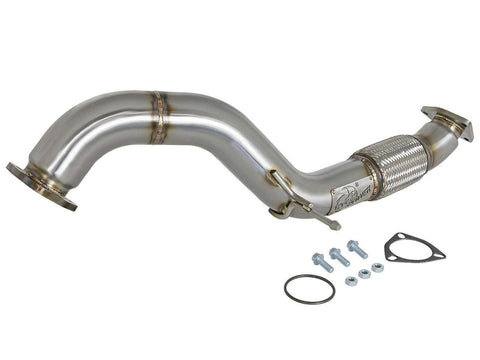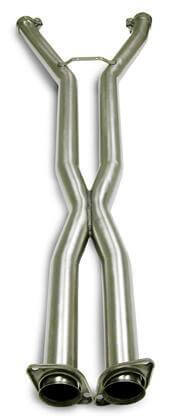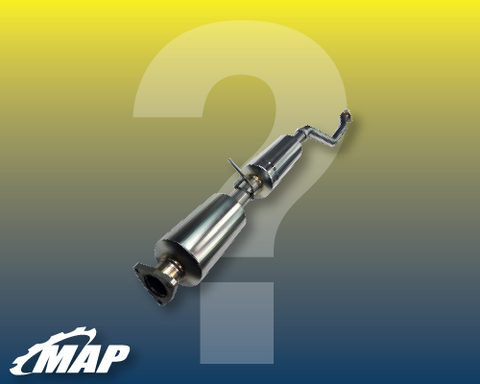What is a midpipe?
A midpipe is an exhaust pipe that sits in the middle of your exhaust system–Captain Obvious, right? It might seem redundant, but there are some essential functions that a midpipe has. Read on to learn more about the function of this vital component.
What does a midpipe do?
Midpipes are stainless steel exhaust pipes that run from the beginning of your exhaust system to the muffler. They equalize the exhaust coming from the set of headers and help cars release sounds and fumes, which allow vehicles to be environmentally friendly.
Aftermarket midpipes are equipped with a right-angled connecting tube or multiple attached pipes. The reason for this is to balance the pressure in your exhaust system, responsible for high-performance.
As cylinders fire, exhaust fumes are forced through the headers to the front of the exhaust system at different intervals. The midpipe equalizes this mashup of fumes before pushing them through the rest of the exhaust system.
Be sure to check out our midpipe products.

Where is the midpipe located?
Midpipes are usually found between the headers and exhaust muffler. The muffler mounts to the midpipe, which, as we explained above, carries sound and fumes from one part of the exhaust system to another–usually in an organized bundle or system. Upgrading midpipes simultaneously as your muffler will often result in better performance, as most aftermarket midpipes have a larger diameter and are more durable than just-good-enough stock pipes.
Midpipe vs. Downpipe
When you look at the middle section of the exhaust system, you will notice two pipes: one on top (the downpipe) and one below (the midpipe). The purpose of both is the same: release fumes and noise as sparingly as possible. The downpipe and midpipe are similar-functioning components, except a downpipe is usually referenced when you have a turbo. The downpipe attaches to your exhaust system at the front, while a midpipe extends from towards its end between catalytic converters or mufflers.
Does a Midpipe Add Horsepower?
Yes–though slight. If you're looking to upgrade your car’s sound, an aftermarket midpipe is the way to go. However, you shouldn’t expect a high amount of horsepower from this kind of mod. Aftermarket pipes are usually wider than stock pipes, so you’ll gain more horsepower, but not a serious amount. With performance driving, even the slightest increase in power could earn you a trip to the winner’s circle. And getting a larger diameter midpipe opens up the fume pathways so your car can breathe a little better–instantly adding more functionality.
Does an Aftermarket Midpipe Make Your Car Louder?
Yes. Wide-diameter midpipes will make a vehicle's exhaust system more efficient and free-flowing, increasing its noise output. It does depend on which midpipe you install, though. A midpipe with just a resonator and no catalytic converter would pump sound like mad.
There are two different kinds of midpipes with different flow patterns and pipe configurations: labeled H and X, respectively. The H-style pipe and the X-style pipe both have a different appearance, noise, and tone outputs. Keep reading so you can complement the sound of your car by choosing the right exhaust system.
X-style pipe
If you're looking for that high-pitched tone, some distortion, and more power at higher speeds (higher RPMs), then an X-pipe is an excellent choice. The X-tube pipe gets its name from the vertical connecting tube merging in the shape of the letter X.

H-style pipe
H-pipes have an aggressive, deep rumbling noise, like what you'd hear in a muscle car. Offering more torque at lower speeds than X-tube products, H-tube pipes are a type of curved perpendicular connecting pipe that creates the letter H.

Which midpipe is best?
You should take into consideration what components are in your vehicle currently, and what mods or upgrades might be on your list before making any decisions about which midpipes will work best. There are a lot of different parts that you can upgrade your car with and many mods or upgrades available.
But really, the ultimate question when deciding between an X-style exhaust pipe and H-pipes? The sound. Remember that X-tubes are high-pitched and H-tubes are low and rumbling.
So if you want more pressure, more speed at higher RPMs, and beautiful high-pitched tones, you should invest in an X-tube. But if you want more power/torque at lower speeds and growly tones, an H-tube is the right choice.
MAPerformance carries midpipe products
We know you're looking for something that will make your car sound like it was born to be wild. That's why we’re constantly stocking midpipe products with new modifications and upgrades, so we can deliver the perfect balance of power and performance!
For the best selection of exhaust system high-quality products with solid engineering, MAPerformance has your back.
Similar products:





Comments (0)
There are no comments for this article. Be the first one to leave a message!